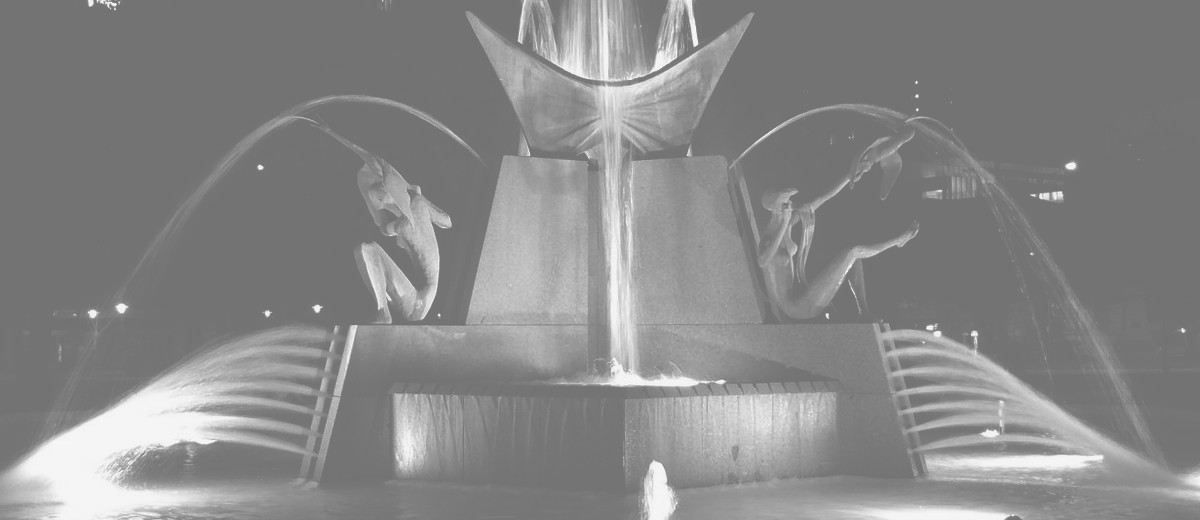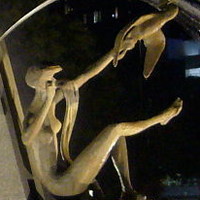Thing
ContributeThe Three Rivers fountain commemorates the visit of Queen Elizabeth II and the Duke of Edinburgh in 1963. It is the central component of a redevelopment of Victoria Square that took place in the 1960s.
Striking a new note
The idea for a commemorative fountain was raised early in 1962 by architect and Adelaide City Council alderman James Irwin. He argued for a change from the tradition of decorating the city for visiting royalty. Irwin hoped the Council 'will strike a new note and not put streamers and bunting up [but] do something permanent for the City ... the building of a worthy fountain'.
Stimulated by overseas travel, Irwin had a grand vision for new fountains in Adelaide. He wanted fountains in all of the squares and four in the corners of Victoria Square. He envisaged 'squirts of water all over the place', with a spectacular main jet, 'It's got to go right up, 130 feet'.
Some members of the Special Council Committee set up to investigate a fountain suggested closing Victoria Square so that a single large feature could be seen all the way along King William Street. However, this proposal was initially rejected. The committee was correct in assuming that any such proposal would meet with opposition and would 'take years'. It investigated alternative sites on North Terrace, Light Square, Pennington Gardens and in the centre or corners of Victoria Square. It sought advice from the principal of the School of Arts, Allan Sierp, and sculptor John Dowie.
By February 1963 the committee favoured a redeveloped Victoria Square with a large fountain at its heart. The City Council debated the location of a fountain at the top of King William Street, which would be re-routed to accommodate it.
Controversy
Newspaper reports welcomed a commemorative fountain, but reservations quickly surfaced about any moves to alter the street layout of the square. Editorials and banner headlines fanned public debate. Letters to the editor for and against street changes proliferated. Members of the public were stopped in the street and asked for their opinions.
Organisations such as the South Australian Passenger Services Association, whose members had buses that used the square, opposed the site because it would be a 'serious traffic hazard'. This view was shared by the police commissioner. City traders, led by Mr J F Trim, launched a petition against any moves to re-route King William Street.
At the end of May 1965, after much debate, deferrals and re-costing, the City Council finally determined, on the casting vote of then Lord Mayor Irwin, to close King William Street through the centre of the square. John Dowie was commissioned to design a commemorative fountain.
The fountain’s design
Dowie’s design was inspired by both tradition and the site. He was quoted in the Advertiser on 22 February 1967: ‘It’s an ancient tradition for fountains to honor the gods of the rivers that feed it. We have no river gods, but the water feeding this fountain will come from the Murray, the Onkaparinga and the Torrens and I decided to make it symbolic of this’. The rivers were represented by human figures and birds: ‘I made the two lesser rivers female figures (a woman and a black swan for the Torrens and a woman with a heron for the Onkaparinga). These are the cultivated areas, so I made the women European. But the old substantial Murray is male and had to be Aboriginal’. The Aboriginal man holds an ibis.
The three figures also echoed the triangular site made by the diagonal roadways. The whole construction was designed to be ‘a spectacle’, able to be viewed from all angles, and dominating the northern end of the square and the vista along King William Street north.
As well as adding to the controversy surrounding the redevelopment, the design adopted by the Council on 15 February 1967 was indeed a spectacle.
The three-sided fountain sits in an 18m-wide hexagonal pool with an outer wall of unpolished Angaston marble. Three Harcourt granite pedestals support the large cast aluminium basin and the aluminium figures. The basin reaches 4.6m above the ground. When the fountain is fully operational jets of water rise a further 4m from the basin, giving an overall height of 9m. Water cascades from the central bowl into three mid level pools and then via a fringe of streams into the main pool below. A further 33 jets of water shoot from the central pedestal and the main pool.
The 3.3m-wide basin was cast in one piece. It weighs 1800kg. The three figures weigh 227kg each.
The fountain in use
The fountain was switched on by the Duke of Edinburgh on a subsequent visit on 28 May 1968. He commented ‘although there is not material advantage in having a fountain, it will give future citizens a great deal of pleasure, and no doubt a great deal to argue about’. He is reputed to have called the modernist fountain 'a monstrosity'; a view shared by a council gardener, James Purcell. James Irwin, however, noted the shift in public art that the fountain represented. It was something Adelaide could be proud of.
In March 2012 the Three Rivers was placed on the South Australian Heritage Register. The latest redevelopment of Victoria Square, which began in 2013, saw the fountain relocated to the southern side of the square.
Media
Add mediaImages

National Library of Australia, an24836482.

Adelaide's Victoria Square Fountain at night time, 2008, http://en.wikipedia.org/wiki/File:Adelaide_VictoriaSq_Fountain_Night2.JPG, Public Domain

Image Courtesy of Aussie Rambling, CC-BY



Comments
CommentAdd new comment
What a find Steven!
I was lucky enough to purchase the original Dowie Marquettes from his estate sale here a Christies Auction some years back...
Have you considered registering the event in the History Festival Maria? I think registrations for the printed program have closed now, but you can still promote the event on the History Festival website if you register, contact historyfestival@history.sa.gov.au for more.
The Victoria Square Fountain Club is hosting a 50th Gold Anniversary Dinner at the Adelaide Hilton on Thursday May the 24th 2018 to celebrate 50years since the fountain was swiched on in 1968 by HRH the Duke of Edinburgh, to attend or enquire contact founder of the VSF Club Maria Kenda AM 0439978619 or mariva8@bigpond.com
It's back in place now Simon.
I'm afraid we can't answer that Simon. You will need to check with the Adelaide City Council. They do take public artworks off display from time to time when they need cleaning or other work done to them. There may be something holding up the return.
I've been wondering where the 3rd statue is for some time...at least a year!
Still only 2 river statues. Council doesn't reply to emails. They probably don't know its gone
I obviously haven't been past in a while Anthony, there were three last time I looked.
You'd need to enquire with the Adelaide City Council to find out where it is, but my first guess would be it's been taken for conservation work.
Does anyone know where the third figure is? It has only had two for a while now.
Noted Tim! I do like the new location though, I know people were concerned about the changes but there's a great vista through the square now (in daylight).
Yes, the 'disco' lights are dreadful.
The fountain is certainly attracting a lot of attention in its new location Michael. Good to see people passionate about its history.
The Three Rivers Fountain is a 1960's icon by one of Australia's most revered artists John Dowie.
The new location at the southern end of Victoria Square is a delight and gives a marvellous focal point to the southern point of the square.
Unfortunately the new multi coloured lighting is an act of desecration. John Dowie designed the fountain to be lit with standard high wattage incandescent light, and this should be the case now, yellow/white light as in all the major classical fountains around the globe. (Maybe more energy efficient technology but certainly ONLY yellow/white light.)
I urge the Adelaide City Council to respect this extraordinary icon and work of art by addressing the correct lighting colour.